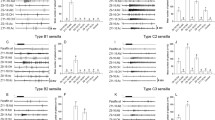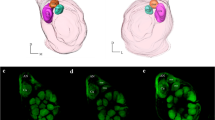Summary
Temporal response characteristics of three cell types of maleA. polyphemus, each responding to a different pheromone component, have been measured using series of short (20 ms) pheromone pulses. The stimuli were delivered through capillaries 20 μm in diameter and applied to single olfactory sensilla trichodea. Two of three cell types sensitive to (E,Z)-6,11-hexadecadienal and (E,Z)-4,9-tetradecadienyl acetate are able to resolve at least 5 stimuli/s whereas the third, responding to the major pheromone component (E,Z)-6,11-hexadecadienyl acetate, is slower, resolving only about 2 stimuli/s. These results suggest that receptor cells are able to respond to pulses of pheromone concentration as they occur downwind from a point source. The time-averaged number of nerve impulses does not seem to be a reliable measure of the amount of pheromone reaching the sensillum. Responses of the cells thus reflect the non-uniform distribution of pheromone in a plume rather than the average concentration.
Similar content being viewed by others
References
Baker TC, Roelofs WL (1981) Initiation and termination of oriental fruit moth male response to pheromone concentrations in the field. Environ Entomol 10:211–218
Baker TC, Willis MA, Phelan PL (1984) Optomotor anemotaxis polarizes self-steered zigzagging in flying moths. Physiol Entomol 9:365–376
Baker TC, Willis MA, Haynes KF, Phelan PL (1985) A pulsed cloud of sex pheromone elicits upwind flight in male moths. Physiol Entomol 10:257–265
Baker TC, Vogt RG (1988) Measured behavioural latency in response to sex-pheromone loss in the large silk mothAntheraea polyphemus. J Exp Biol 137:29–38
Bestmann HJ, Attygalle AB, Brosche T, Erler J, Platz H, Schwarz J, Vostrowsky O, Wu CH (1987) Identification of three sex pheromone components of the female Saturniid mothAntheraea pernyi (Lepidoptera: Saturniidae). Z Naturforsch 42c: 631–636
Boeckh J, Kaissling KE, Schneider D (1960) Sensillen und Bau der Antennengeißel vonTelea polyphemus. Zool Anat 78:559–584
Bossert WH, Wilson EO (1963) The analysis of olfactory communication in animals. J Theor Biol 5:443–469
Cardé RT (1986) Epilogue: behavioural mechanisms. In: Payne TL, Birch MC, Kennedy CEJ (eds) Mechanisms in insect olfaction. Clarendon Press, Oxford, pp 175–186
Cardé RT, Baker TC, Roelofs WL (1975) Ethological function of components of a sex attractant system for oriental fruit moth males,Grapholitha molesta (Lep. Tort.). J Chem Ecol 1:475–491
Christensen TA, Hildebrand JG (1988) Frequency coding by central olfactory neurons in the sphinxmothManduca sexta. Chem Senses 13:123–130
Kaissling KE (1974) Topical stimulation of the outer dendrites of single olfactory cells in saturniid moths. Abstr 1st ECRO Congr Paris, p 26
Kaissling KE (1977) Structures of odour molecules and multiple activities of receptor cells. In: Le Magnen J, MacLeod P (eds) Int Symp Olfaction and Taste VI. Information Retrieval, London pp 9–16
Kaissling KE (1979) Recognition of pheromones by moths, especially in Saturniids andBombyx mori. In: Ritter FJ (ed) Chemical ecology and odour communications in animals. Elsevier/North Holland, Biomedical Press, Amsterdam, pp 43–56
Kaissling KE (1986) Temporal characteristics of pheromone receptor cell responses in relation to orientation behaviour of moth. In: Payne TL, Birch MC, Kennedy CEJ (eds) Mechanisms in insect olfaction. Clarendon Press, Oxford, pp 193–200
Kaissling KE, Zack Strausfeld C, Rumbo ER (1987) Adaptation processes in insect olfactory receptors. Mechanisms and behavioral significance. Ann NY Acad Sci 510:104–112
Kaissling KE, Meng LZ, Bestman HJ (1989) Responses of bombykol receptor cells (E,Z)-4,6-hexadecadiene and linalool. J Comp Physiol A 165:147–154
Kennedy JS (1986) Some current issues in orientation to odour sources. In: Payne TL, Birch MC, Kennedy CEJ (eds) Mechanisms in insect olfaction. Clarendon Press, Oxford pp 11–25
Kochansky J, Tette J, Taschenberg EF, Cardé KE, Kaissling KE, Roelofs WL (1975) Sex pheromone of the mothAntheraea polyphemus. J Insect Physiol 21:1977–1983
Kramer E (1986) Turbulent diffusion and pheromone-triggered anemotaxis. In: Payne TL, Birch MC, Kennedy CEJ (eds) Mechanisms in insect olfaction. Clarendon Press, Oxford, pp 59–68
Linn CE, Gaston LK (1981) Behavioral function of the components and the blend of the sex pheromone of the cabbage looper,Trichoplusia ni. Environ Entomol 10:751–755
Linn CE, Bjostad LB, Du JW, Roelofs WL (1984) Redundancy in a chemical signal: Behavioral responses of maleTrichoplusia ni to a 6-component sex pheromone blend. J Chem Ecol 10:1635–1658
Linn CE, Campbell MG, Roelofs WL (1987) Pheromone components and active spaces: what do moths smell and where do they smell it? Science 237:650–652
Meng LZ, Wu CH, Wicklein M, Kaissling KE, Bestmann HJ (1989) Number and sensitivity of three types of pheromone receptor cells inAntheraea pernyi andA. polyphemus. J Comp Physiol A 165:139–146
Murlis J (1986) The structure of odour plumes. In: Payne TL, Birch MC, Kennedy CEJ (eds) Mechanisms in insect olfaction. Clarendon Press, Oxford pp 27–38
Murlis J, Jones CD (1981) Fine-scale structure of odour plumes in relation to insect orientation to distant pheromone and other attractant sources. Physiol Entomol 6:71–86
Rumbo ER (1983) Differences between single cell responses to different components of the sex pheromone in males of light-brown apple moth (Epiphyas postvittana). Physiol Entomol 8:195–201
Willis MA, Baker TC (1984) Effects of intermittent and continuous pheromone stimulation on the flight behaviour of oriental fruit moth,Grapholita molesta. Physiol Entomol 9:342–358
Wright RH (1958) The olfactory guidance of flying insects. Can Entomol 90:81–89
Zack C (1979) Sensory adaptation in the sex pheromone receptor cells of Saturniid moths. Dissertation, Fak Biol Universität München
Zack Strausfeld C, Kaissling KE (1986) Localized adaptation processes in olfactory sensilla of Saturniid moths. Chem Senses 11:499–512
Author information
Authors and Affiliations
Rights and permissions
About this article
Cite this article
Rumbo, E.R., Kaissling, K.E. Temporal resolution of odour pulses by three types of pheromone receptor cells inAntheraea polyphemus . J. Comp. Physiol. 165, 281–291 (1989). https://doi.org/10.1007/BF00619348
Accepted:
Issue Date:
DOI: https://doi.org/10.1007/BF00619348




